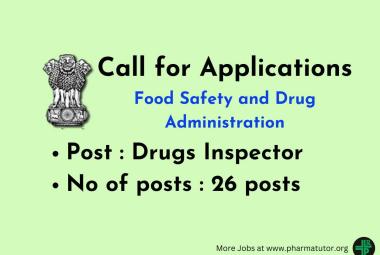 ABOUT AUTHOR:
ABOUT AUTHOR:
Devesh Sharma
M.Pharm-DRA
School of Pharmaceutical Sciences, JNU, Rajasthan
Trainee, Chemist, Ind-swift labs ltd, Mohali, (punjab)
devesh.m.pharmdra@gmail.com
ABSTRACT:
Corrective and Preventive Action (CAPA)is a concept within Good Manufacturing Practice (GMP). CAPA focuses on the systematic investigation of discrepancies (failures and/or deviations) in an attempt to prevent their recurrence. To ensure that corrective and preventive actions are effective, the systematic investigation of the failure incidence is pivotal in identifying the corrective and preventive actions undertaken. CAPA is part of the overall quality management system.CAPA is of paramount importance to the FDA. According to FDA documents CAPA accounts for 30-50% of FDA-483 forms issued for non compliance.
[adsense:336x280:8701650588]
Reference Id: PHARMATUTOR-ART-1264
INTRODUCTION:
The pharmaceutical company should have a system for implementing corrective actions and preventive actions resulting from the investigation of complaints, product rejections, non-conformances, recalls, deviations, audits, regulatory inspections and findings, and trends from process performance and product quality monitoring. A structured approach to the investigation process should be used with the objective of determining root cause. The level of effort and formality of the investigation should be commensurate with the level of risk. CAPA methodology should result in product and process improvements and enhanced product and process understanding. CAPA is a concept within good manufacturing practice(GMP). It focuses on the systematic investigation of the root causes of non-conformities in an attempt to prevent their recurrence (for corrective action) or to prevent occurrence (for preventive action).
Implementation of Corrective & preventive actions is the path towards improvement & effectiveness of Quality Management system. Corrective actions are nothing but the action/s based on the problem identification. The problem or a non-conformance can be identified internally through staff suggestions, management reviews, document reviews or internal audits. Customer complaints / suggestions, customer rejections, non-conformities raised in customer / third party audits & recommendations by the auditors are the external sources which lead to find the root cause of the problem.
Corrective action is a reaction to any of the cause/non-conformance mentioned above & can be divided in two phases of action:
1) Identification of root cause: for this purpose TQM tools such as fish-bone or cause & effects analysis can be practiced. Your CAPA would be appropriate & effective if & only if you have identified the root cause of problem.
2) Taking necessary actions: in order to address the root cause takes necessary immediate action/s. The effectiveness of the corrective action taken has to be verified periodically through a systematic approach of PDCA(Plan - Do - Check - Act) cycle.
Preventive action is prediction of problem & trying to avoid the occurrence (fail safe) through self initiated action/s & analysis related with your processes / products. This can be initiated with the help of active participation of staff members / workers through improvement teams, improvement meetings, management review, customer feedback & deciding own goals quantized in terms of business growth, reducing rejections, utilizing the equipments effectively etc.1,2
Application of Corrective Action/Preventive Action throughout the Product Lifecycle
|
Development |
Technology Transfer |
Manufacturing |
Product Discontinuation |
|
Product or process variability is explored. CAPA methodology can be useful where corrective actions and preventive actions are incorporated into the iterative design and development process. |
CAPA can be used as an effective system for feedback, feed forward and continual improvement. |
CAPA should be used and the effectiveness of the actions should be evaluated. |
CAPA should continue after the product is discontinued. The impact on product remaining on the market should be considered as well as other products which might be impacted. |
STEPS OF CAPA FOR PHARMACEUTICAL INDUSTRY
Implementing an effective corrective or preventive action capable of satisfying quality assurance and regulatory documentation requirements is accomplished in seven basic steps:
1. Identification:
The initial step in the process is to clearly define the problem. It is important to accurately and completely describe the situation as it exists now. This should include the source of the information, a detailed explanation of the problem, the available evidence that a problem exists.
This should include:
• The source of the information
The specific source of the information is documented. There are many possible sources: Service requests, Internal Quality Audit, Customer complaints, Internal quality audits, Staff observations, Trend data, QA inspections, Process monitoring, Risk analysis, Process performance monitoring, Management review, and Failure mode analysis. This information is important for the investigation and action plan, but also useful for effectiveness evaluation and communicating the resolution of the problem.
• Detailed explanation of the problem
A description of the problem is written that is concise - but complete. The description must contain enough information so that the specific problem can be easily understood.
• Documentation of the available evidence that a problem exists.
List the specific information, documents, or data available that demonstrates that the problem does exist. This information will be very important during the investigation into the problem. For example, the evidence for a product defect may be a high percentage of service requests or product returns. The evidence for a potential equipment problem may be steadily increasing downtime.
• Corrective/Preventive Action Request form
A sample form is provided “Corrective/Preventive Action Request that can be used to initiate a CAPA action and collect the initial information.
2- Evaluation:
The situation must be evaluated to determine both the need for action and then, the level of action required. The potential impact of the problem and the actual risks to the company and/or customers must be determined.
An evaluation should include:
•Potential Impact of the problem
Determine and document specifically why the problem is a concern and what the impact to the company and/or customers may be. Concerns may include costs, function, product quality, safety, reliability, and/or customer satisfaction.
• Assessment of Risk
Using the result of the impact evaluation, the seriousness of the problem is assessed. The level of risk that is associated with the problem may affect the actions that are taken. For example, a problem that presents a serious risk to the function or safety of a product may be assigned a high priority and require immediate remedial action. On the other hand, an observation that a particular machine is experiencing an increasing level of downtime each month may have a lower priority.
•Remedial Action that may be required
The potential impact and risk assessment may indicate a need for some immediate action to remedy the situation until a permanent solution can be implemented. In some cases the remedial action may be adequate. If so, the CAPA can then be closed, after documenting the rationale for this decision and completing appropriate follow up.
• Remedial Action form
A sample “Remedial Action” form is included. This form should be used to explain the steps that must be taken to avoid any further adverse effects.
3- Investigation:
A written procedure for doing an investigation into the problem is created. A written plan helps assure that the investigation is complete and nothing is missed.
This procedure should include:
• The objectives for the action
The objective is a statement of the desired outcome(s) of the corrective or preventive action.
The action will be complete when all aspects of the objective have been met and verified.
• An investigation strategy
A set of specific instructions for determining the contributing and root causes of the problem is written. This procedure directs a comprehensive review of all circumstances related to the problem and must consider: equipment, materials, personnel, procedures, design, training, software, external factors.
•Assignment of responsibility and required resources
An important part of the investigation procedure is to assign responsibility for conducting each aspect of the investigation. Any additional resources that may be required is also identified and documented. For example, specific testing equipment or external analysis may be required.
• Investigation Procedure form
A sample “Investigation Procedure” form is included. This is a written plan of action for the investigation into the problem. It should include the overall objective and the instructions for conducting the investigation. The person or persons responsible for the investigation and an expected completion date should also be entered.2,3
4 - Analysis:
The investigation procedure is used to conduct the investigation into the cause of the problem. The goal of this analysis is primarily to determine the root cause of the problem described, but any contributing causes are also identified.
•Every possible cause is identified and appropriate data collected.
A list of all possible causes is created which then form the basis for collecting relevant information, test data, etc.
The necessary data and other information is collected that will be used to determine the primary cause of the problem.
•The results of the data collection are documented and organized.
Data may come from a variety of sources: testing results and/or a review of records, processes, service information, design controls, operations, and any other information that may lead to a determination of the fundamental cause of the problem. The data collected is organized into a useable form. The resulting documentation should address all of the possible causes previously determined. This information is used to determine the root cause of the problem. The effectiveness of the analysis will depend on the quality and thoroughness of the information available.
•Everything related to the problem must be identified, but the primary goal must be to find the root cause
Use the data to complete a Root Cause Analysis. This involves finding the actual cause of the problem rather than simply dealing with the symptoms. Finding the primary cause is essential for determining appropriate corrective and/or preventive actions.
• Problem Analysis form
A sample “Problem Analysis” form is included. This form is optional but is intended to be used for recording information related to the analysis of the problem. The form can be used as a collection point for the information discovered during the analysis and any supporting data or documentation can be attached.
5- Action Plan:
Using the results from the analysis, the best method(s) for correcting the situation (or preventing a future occurrence) is determined and act ion plan developed. All of the tasks required to correct the problem and prevent a recurrence are identified and incorporated into an action plan.
The plan includes changes that must be made and assigns responsibility for the tasks. The action plan should also identify the person or persons responsible for completing each task.
•Actions to be completed
List all activities and tasks that must be accomplished to correct the existing problem or eliminate a potential problem, and prevent a recurrence. It is very important identify all actions necessary to address everything that contributed to or resulted from the situation.
• Document or Specification Changes
Needed changes to documents, processes, procedures, or other system modifications should be described. Enough detail must be included so it is clearly understood what must be done and what the outcome of the changes should be.
• Process, Procedure, or System changes
if any changes to processes, procedures, or systems must be made they are described. Enough detail should be included so that it is clearly understood what must be done. The expected outcome of these changes should also be explained.
• Employee Training
Employee training is an essential part of any change that is made and should be made part of the action plan. To be effective, all modifications and changes made must be communicated to all persons, departments, suppliers, etc. that were or will be affected.
• Action Plan form
A sample “Action Plan” form is included. This should provide a set of written procedures that detail all of the actions that must be done to resolve the problem and prevent it from recurring. This includes corrective and preventive activities, document changes, training, etc. The person or persons responsible and an expected completion date should also be entered on the form. 3,4,5
6-Implementation
The corrective / preventive action plan that has been created is now implemented. All of the required tasks listed and described in the action plan are initiated, completed, and documented.
• Implementation Summary
All of the activities that have been completed as required in the “Action Plan” should be listed and summarized. This section should contain a complete record of the actions that were taken to correct the problem and assure that it will not recur. This includes changes, preventive measures, process controls, training, etc.
• Documentation
All documents or other specifications that have been modified are listed. Typically the documentation would be attached to a final printed report of this CAPA action. This will facilitate verification of the changes for the follow up.
7 - Follow Up
One of the most fundamental steps in the CAPA process is completing an evaluation of the actions that were taken. This evaluation must not only verify the successful completion of the identified tasks, but also assess the appropriateness and effectiveness of the actions taken.6,7
•Key questions
Have all of the objectives been met? (Did the actions correct or prevent the problem with assurances that the same situation will not happen again?)
Have all recommended changes been completed and verified?
Has training and appropriate communications been implemented to assure that all relevant employees understand the situation and the changes that have been made?
Has an investigation demonstrated that that the actions taken have not had any additional adverse effect on the product or service?
•Verification results
Make sure that appropriate information has been recorded that provides proof that all actions have been completed successfully.
•Validation results
A validation of the action is done. This must document that:
o The root cause of the problem has been solved,
o Any resulting secondary situations have been corrected,
o Proper controls have been established to prevent a future occurrence,
o The actions taken had no other adverse effects.
o Adequate monitoring of the situation is in place.
Completion
When the Follow Up has been finished, the CAPA is complete. It should be dated, and signed by appropriate, authorized personnel.7,8,9
[adsense:468x15:2204050025]
CONCLUSION:
CAPAplays important role in risk management system. CAPA methodology should result in product and process improvements and enhanced product and process understanding.Implementation of Corrective & preventive actions is the path towards improvement & effectiveness of Quality Management system.
REFERENCE:
1.“ PHARMACEUTICAL QUALITY SYSTEM “
fda.gov/downloads/RegulatoryInformation/Guidances/ucm128031.pdf
2 ”Corrective and preventive action”. wikipedia.org/wiki/Corrective_and_preventive_action
3. “Complete Procedure of CAPA for Pharmaceutical Industry”, formulation.vinensia.com/2012/01/complete-procedure-of-capa-for_06.html
4.”CAPA and Root Cause Analysis”, pharmamanufacturing.com/articles/2006/145
5. “A Risk Modeling Framework for the Pharmaceutical Industry”, iima.org/CIIMA/4%20CIIMA%207-1-07%20Adis%201-10.pdf
6. Guidance for Industry, fda.gov/.../2005-4136b1_05_pharmaceutical%20CGMP.pdf
7. FDA-compliance-pharmaceutical-industry, caracorp.com/FDA-compliance-pharmaceutical-industry.php
8. FDA, EU expecting manufacturers to use CAPA to halt OOS, determine 'root cause'
findarticles.com/p/articles/mi_hb5677/is_9_5/ai_n29033453
9. CFR - Code of Federal Regulations Title 21, accessdata.fda.gov/scripts/cdrh/cfdocs/cfcfr/CFRSearch.cfm?CFRPart=820
NOW YOU CAN ALSO PUBLISH YOUR ARTICLE ONLINE.
SUBMIT YOUR ARTICLE/PROJECT AT articles@pharmatutor.org
Subscribe to Pharmatutor Job Alerts by Email
FIND OUT MORE ARTICLES AT OUR DATABASE









